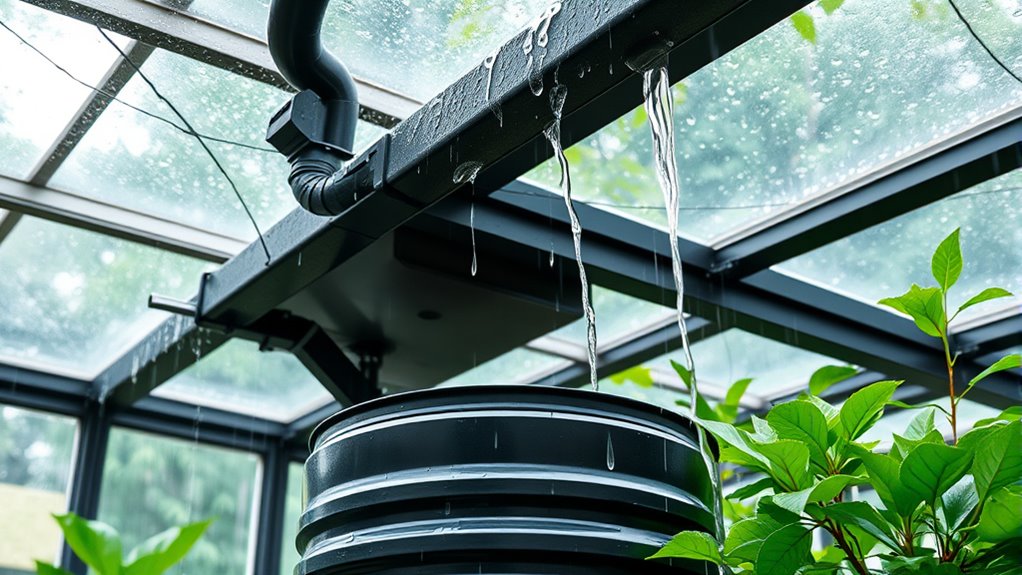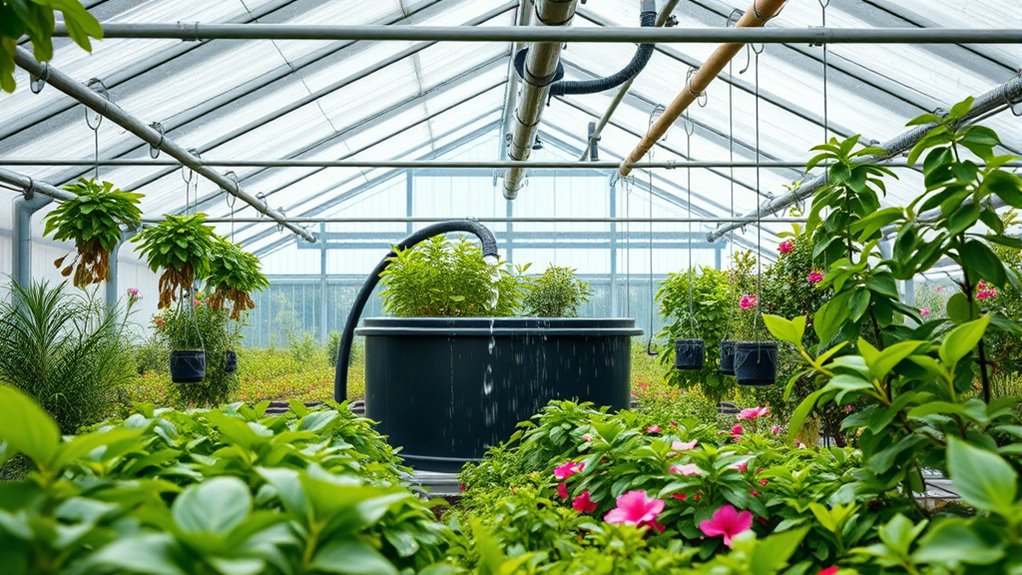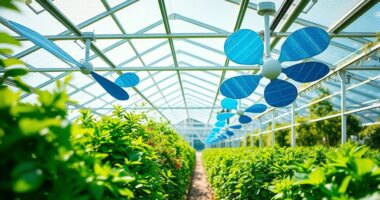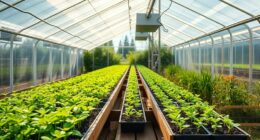Using collected rainwater to water your greenhouse is a smart, eco-friendly choice that supports sustainable gardening. It provides a clean, soft water source free from salts and chemicals, which can improve plant health and yields. Setting up a rainwater harvesting system with collection surfaces, filters, and storage tanks is simple and helps conserve municipal water. Plus, it eases pressure on local drainage systems. Keep exploring to learn more about creating an efficient, long-lasting setup that benefits both your plants and the environment.
Key Takeaways
- Collect rainwater on roofs or catchment areas to ensure a sustainable water source for your greenhouse.
- Use filters to remove debris before storing rainwater, maintaining clean water for plants.
- Install gravity-fed irrigation systems, such as drip lines or hoses, for efficient watering of greenhouse plants.
- Regularly maintain and clean the system to prolong its lifespan and ensure optimal water quality.
- Utilizing harvested rainwater reduces dependence on municipal water, lowers costs, and promotes eco-friendly gardening practices.

Have you ever considered how collecting rainwater can benefit your home and the environment? When you harvest rainwater, you’re actively contributing to urban sustainability and water conservation efforts. In many cities, water resources face increasing pressure from population growth and climate change, making it essential to find alternative solutions. By capturing rainwater, you reduce your reliance on municipal water systems, which often draw from distant sources that strain local ecosystems. This not only eases the burden on public water supplies but also helps decrease your water bills, saving you money in the long run.
Using collected rainwater for your greenhouse is an effective way to make your gardening practices more sustainable. Greenhouses require consistent watering, and relying solely on tap water can be wasteful and less eco-friendly. Rainwater is naturally soft, free from the salts and chemicals often found in municipal supplies, making it ideal for plants. When you use rainwater, you’re providing your greenhouse with a cleaner source of hydration, which can improve plant health and yield. Plus, harvesting rainwater ensures a steady supply during dry spells, reducing the need to turn on external water sources and further supporting water conservation.
Implementing a rainwater harvesting system for your greenhouse is straightforward. Start by installing a collection surface, like a roof or a dedicated catchment area, connected to a storage tank. Ensure your system includes filters to remove debris and prevent clogging of your watering equipment. When you water your plants, use a simple gravity-fed drip system or a hose connected to your tank. This setup allows you to water efficiently, avoiding overuse and runoff that could lead to erosion or water wastage. Over time, you’ll notice your plants thrive with this natural, sustainable water source, and you’ll feel good knowing you’re doing your part for urban sustainability.
Using rainwater also helps reduce the strain on local stormwater systems, which often become overwhelmed during heavy rains, leading to flooding and pollution. By capturing rain on your property, you’re helping to mitigate these issues and promote a healthier environment. This practice aligns with broader efforts to create greener, more resilient urban spaces. Not only does it benefit your greenhouse and garden, but it also contributes to the collective goal of conserving water and preserving natural resources. Incorporating proper storage solutions and maintenance routines ensures your system remains effective and prolongs its lifespan. In the end, collecting rainwater isn’t just a practical solution—it’s a simple yet impactful way to support a more sustainable future for your community and the planet.
Frequently Asked Questions
How Much Rainwater Can a Typical Greenhouse’s Collection System Store?
Your greenhouse’s rainwater capacity depends on the size of your collection system and storage tanks. Typically, a well-designed setup can store several hundred gallons, but storage limitations may restrict this amount. To maximize efficiency, you should consider tank size and your area’s rainfall frequency. Keep in mind, larger tanks can hold more water, but space and cost can pose constraints. Proper planning helps you make the most of your rainwater collection.
What Are the Costs Associated With Installing a Rainwater Harvesting System?
Did you know installing a rainwater harvesting system can cost between $1,000 and $10,000? A thorough cost analysis helps you understand expenses like tanks, gutters, and filters. Funding options, including grants or loans, can ease your investment. While costs vary based on size and complexity, the long-term savings on water bills often outweigh initial costs. Planning carefully guarantees you choose a system that fits your budget and needs.
Are There Specific Filters Needed to Keep Rainwater Clean for Plants?
You should use specific filters for rainwater filtration to keep the water clean for your plants. These filters remove debris, dirt, and contaminants, improving water quality. It’s also wise to perform water quality testing regularly to guarantee safe levels of nutrients and pollutants. Proper filtration and testing help maintain healthy plants and prevent issues caused by contaminated water, making your rainwater harvesting system more effective and sustainable for your greenhouse.
How Often Should I Clean and Maintain My Rainwater Collection System?
Think of your rainwater system as a garden that needs regular tending. You should clean and inspect your system sanitation at least twice a year, more often if you notice debris or algae. Maintain a consistent maintenance schedule to prevent clogs and contamination, ensuring your water stays pure for your plants. Regular care keeps your system humming smoothly, just like a well-oiled machine, giving your greenhouse the best water possible.
Can Rainwater Harvesting Reduce My Overall Water Bill Significantly?
You’ll find that rainwater harvesting can considerably reduce your water bill through cost savings and water conservation. By collecting and using rainwater, you decrease your reliance on municipal water, especially during dry seasons. This eco-friendly approach not only lowers expenses but also helps preserve natural resources. With proper system maintenance, you maximize efficiency, making your water use more sustainable and cost-effective over time.
Conclusion
By harvesting rainwater, you protect your plants, save your resources, and nurture your greenhouse. You embrace sustainability, reduce waste, and foster growth. You connect with nature, honor your environment, and cultivate resilience. Rainwater harvesting isn’t just about collecting water—it’s about caring for your greenhouse, honoring the planet, and building a sustainable future. Every drop you save empowers you, inspires you, and helps you create a thriving, eco-friendly haven.









